Building and Construction
40 Pages8249 Words431 Views
Added on 2022-11-28
About This Document
This document provides information on establishing clear lines of communication on a construction site, selecting the best communication methods, project plans and specifications, cost estimation for building projects, progress payments, on-site communication activities, and more.
Building and Construction
Added on 2022-11-28
ShareRelated Documents
Running Head: BUILDING AND CONSTRUCTION
Building and Construction (Building)
Student’s Name
Institution
Building and Construction (Building)
Student’s Name
Institution
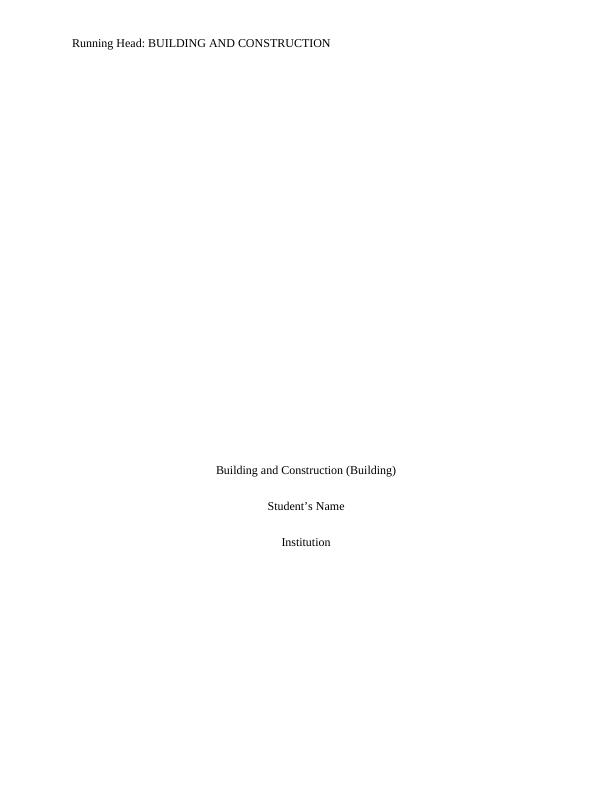
BUILDING AND CONSTRUCTION 2
Question 1: How would you establish clear lines of communication on a construction site?
Create a communication chain that is formal by having specific points of accessing
relevant information and spreading it to the concerned individuals at a reasonable time.
Have a suitable platform for messages; at times it may be difficult to convey information
in many paragraphs. Therefore, consider using one- on - one meetings or phone calls.
(Barrick, Thurgood, Smith, & Courtright, 2015)
Be positive and transparent through trusting, motivating the crew members and showing
the willingness to dialogue openly.
Use technology that is able to convey crucial information to the crew.
Convey timely, concise and clear information.
Question 2: Discuss the methods of communication available to you and how to select the
best communication method.
a. Modes of communication
i. Formal briefings that are crucial to communicating to mass audiences.
ii. Newsletters which are suitable for public awareness thus must be colourful and
interesting.
iii. Face to face mode; while communicating face to face, the body language of a person
speak enough about them (Allen, Thallon, & Schreyer, 2017 ).
iv. Poster and notices are suitable for promotions and change of information.
v. Intranet websites are suitable where the culture of the organization promotes it and
where it is posted by appropriate individuals.
Question 1: How would you establish clear lines of communication on a construction site?
Create a communication chain that is formal by having specific points of accessing
relevant information and spreading it to the concerned individuals at a reasonable time.
Have a suitable platform for messages; at times it may be difficult to convey information
in many paragraphs. Therefore, consider using one- on - one meetings or phone calls.
(Barrick, Thurgood, Smith, & Courtright, 2015)
Be positive and transparent through trusting, motivating the crew members and showing
the willingness to dialogue openly.
Use technology that is able to convey crucial information to the crew.
Convey timely, concise and clear information.
Question 2: Discuss the methods of communication available to you and how to select the
best communication method.
a. Modes of communication
i. Formal briefings that are crucial to communicating to mass audiences.
ii. Newsletters which are suitable for public awareness thus must be colourful and
interesting.
iii. Face to face mode; while communicating face to face, the body language of a person
speak enough about them (Allen, Thallon, & Schreyer, 2017 ).
iv. Poster and notices are suitable for promotions and change of information.
v. Intranet websites are suitable where the culture of the organization promotes it and
where it is posted by appropriate individuals.
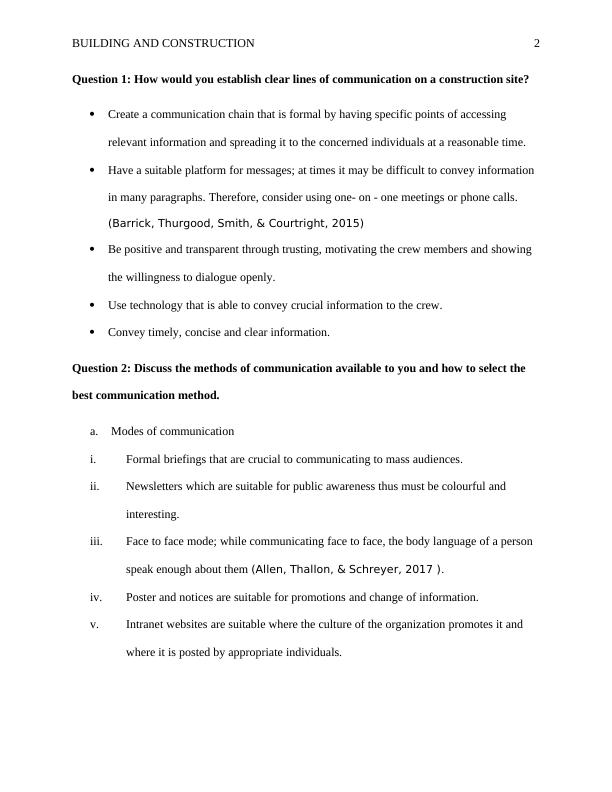
BUILDING AND CONSTRUCTION 3
b. Choosing the appropriate mode
A suitable mode must be able to resolve the following issues:
Who has the responsibility of providing information?
When is the information needed?
The kind of project information that may circulate both externally and internally.
The kind of individual and the type of information they require.
What channel and format shall be used to convey information?
Question 3: List three points that will assist you in ensuring that fees are paid as due
1. Worker preferences; using a method of payment preferred by workers may probably lead
to them getting their salaries in a reasonable time.
2. Maintaining records; keeping proper invoices of workers may make sure that they are
paid in a reasonable time (Borycki & Kushniruk, 2019).
3. Establish the present risks and confidently put in place measure to prevent loss of money.
Question 3: what types of project plan and specifications may be read and interpreted
1. Plans
Contract drawings which are also known as plans refer to the pictorial summary of the suggested
construction. It is comprised of symbols, lines, levels, dimensions and various graphical
characteristics of the structure (Jefferis, Madsen, & Madsen, 2016).
Usually, professional architects who design buildings offer draughts-persons services of drawing
the project’s drawings. The draughts-persons makes sure that the architect's designs are
conveyed accurately and correctly to the builder (Sweet, Schneier, & Wentz, 2014). The
b. Choosing the appropriate mode
A suitable mode must be able to resolve the following issues:
Who has the responsibility of providing information?
When is the information needed?
The kind of project information that may circulate both externally and internally.
The kind of individual and the type of information they require.
What channel and format shall be used to convey information?
Question 3: List three points that will assist you in ensuring that fees are paid as due
1. Worker preferences; using a method of payment preferred by workers may probably lead
to them getting their salaries in a reasonable time.
2. Maintaining records; keeping proper invoices of workers may make sure that they are
paid in a reasonable time (Borycki & Kushniruk, 2019).
3. Establish the present risks and confidently put in place measure to prevent loss of money.
Question 3: what types of project plan and specifications may be read and interpreted
1. Plans
Contract drawings which are also known as plans refer to the pictorial summary of the suggested
construction. It is comprised of symbols, lines, levels, dimensions and various graphical
characteristics of the structure (Jefferis, Madsen, & Madsen, 2016).
Usually, professional architects who design buildings offer draughts-persons services of drawing
the project’s drawings. The draughts-persons makes sure that the architect's designs are
conveyed accurately and correctly to the builder (Sweet, Schneier, & Wentz, 2014). The
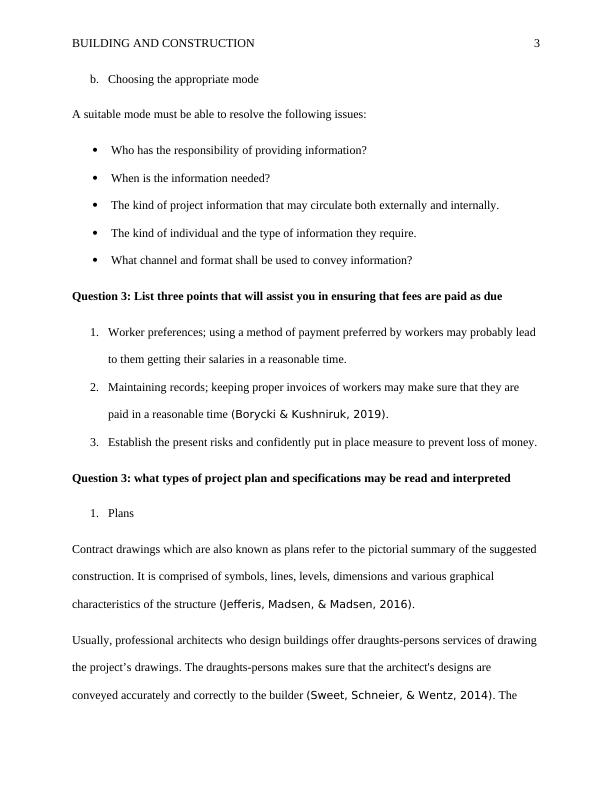
BUILDING AND CONSTRUCTION 4
architectural designs must also consist of required information with respect to the plan so as to
successfully finish building. Drawings for a single-storey construction should comprise of:
Site plan
The floor layout plan views
Elevations
Details
The sewage plan schematic layout
Sectional view
All the drawings must contain labels, notes and dimensions. Every detail needed in the
construction of houses must be provided to the builders including;
2. Specifications
The role of the specification to give a detailed description of the material type to be applied as
well as complement the drawing. Without specifications, builders cannot tell the grade or type of
material needed. Specifications consist of the quality of work and material quantity required
(Botchway & Kwofie, 2019).
i. The quality of work
It has a direct connection with the material type and it’s the major role of specifications. It offers
clear material description such as the kind of sand for making concrete should be graded well
river sand.
architectural designs must also consist of required information with respect to the plan so as to
successfully finish building. Drawings for a single-storey construction should comprise of:
Site plan
The floor layout plan views
Elevations
Details
The sewage plan schematic layout
Sectional view
All the drawings must contain labels, notes and dimensions. Every detail needed in the
construction of houses must be provided to the builders including;
2. Specifications
The role of the specification to give a detailed description of the material type to be applied as
well as complement the drawing. Without specifications, builders cannot tell the grade or type of
material needed. Specifications consist of the quality of work and material quantity required
(Botchway & Kwofie, 2019).
i. The quality of work
It has a direct connection with the material type and it’s the major role of specifications. It offers
clear material description such as the kind of sand for making concrete should be graded well
river sand.

BUILDING AND CONSTRUCTION 5
ii. Quantity
There have never been two buildings that are identical. Therefore, material quantity differs.
Builders must know the material quantity required to finish the suggested structures before
completing the tender and doing costs. Such information is found in the bill of quantities that
comprise of an itemized list of required materials to finish the job (Allen, Thallon, &
Schreyer, 2017 ).
iii. Documentation of contracts
It comprises of state of contracts and deals with issues in respect with:
The extent of the job to be performed
Site access
The contract’s completion and start dates
The worker’s safety and health as well as the public generally
Arrangements for material storage
Temporary site services in terms of toilets, electricity and connection of water
iv. Payment of Contractors
Building contractors are not paid in advance but for the services rendered. The payments are
called interim payments. Contractors should be paid monthly in case of big projects while
payments in small projects are rendered at various stages of construction progress.
ii. Quantity
There have never been two buildings that are identical. Therefore, material quantity differs.
Builders must know the material quantity required to finish the suggested structures before
completing the tender and doing costs. Such information is found in the bill of quantities that
comprise of an itemized list of required materials to finish the job (Allen, Thallon, &
Schreyer, 2017 ).
iii. Documentation of contracts
It comprises of state of contracts and deals with issues in respect with:
The extent of the job to be performed
Site access
The contract’s completion and start dates
The worker’s safety and health as well as the public generally
Arrangements for material storage
Temporary site services in terms of toilets, electricity and connection of water
iv. Payment of Contractors
Building contractors are not paid in advance but for the services rendered. The payments are
called interim payments. Contractors should be paid monthly in case of big projects while
payments in small projects are rendered at various stages of construction progress.

BUILDING AND CONSTRUCTION 6
Question 4: What types of plant and equipment may be estimated and costed for a
building/Construction project?
Types of construction equipment and plant commonly used are (Schaufelberger & Migliaccio,
2019 ):
Bulldozers
Air compressed plant
Breakers
Concreting plants
Bituminous laying and mixing plants
Cherry pickers
Construction skip
Dumpers
Excavator
Question 4: What are progress payments?
Progress billing helps contractors in billing their clients as the project goes on. In order for the
progress billing to be successful, contractors and clients need to agree on a payment schedule
upon the submission of invoices for payment (Flood, 2015). Payments are done on a percentage
that is verified for the completion of the project. Payments are divided in the course of the
project depending on a specific set milestone of either or both parties. The remaining balance is
paid to the contractor upon the client’s satisfaction and on completion of the project.
Question 5: What are examples of on-site communications activities and processes?
Question 4: What types of plant and equipment may be estimated and costed for a
building/Construction project?
Types of construction equipment and plant commonly used are (Schaufelberger & Migliaccio,
2019 ):
Bulldozers
Air compressed plant
Breakers
Concreting plants
Bituminous laying and mixing plants
Cherry pickers
Construction skip
Dumpers
Excavator
Question 4: What are progress payments?
Progress billing helps contractors in billing their clients as the project goes on. In order for the
progress billing to be successful, contractors and clients need to agree on a payment schedule
upon the submission of invoices for payment (Flood, 2015). Payments are done on a percentage
that is verified for the completion of the project. Payments are divided in the course of the
project depending on a specific set milestone of either or both parties. The remaining balance is
paid to the contractor upon the client’s satisfaction and on completion of the project.
Question 5: What are examples of on-site communications activities and processes?
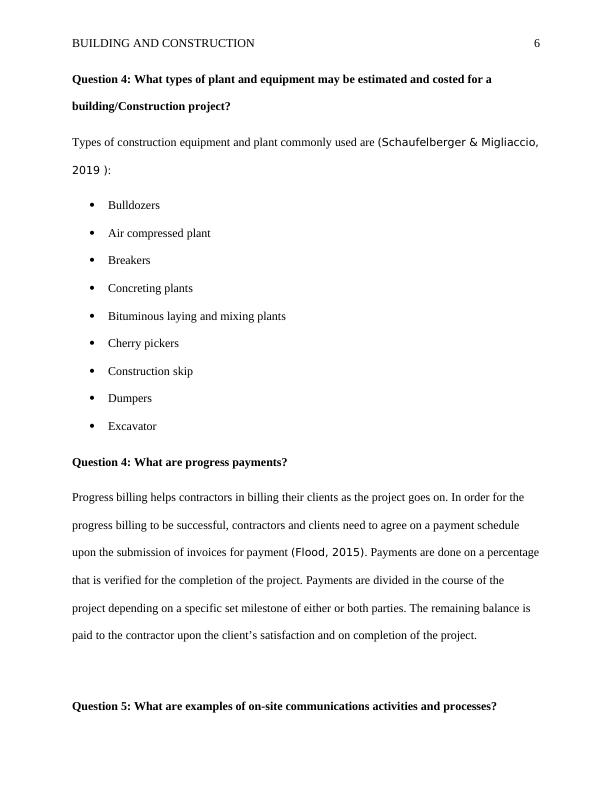
BUILDING AND CONSTRUCTION 7
1. Communication activities
Generally, there exists 3 communication forms namely:
Written form such as reports, emails, legal documents, letters and plans
Oral form such as meeting, telephone, presentations and face to face
Non-verbal form such as gestures
2. Processes of communication
Processes of communication are very critical in offering relevant data so as to transmit messages
clearly and understanding among different stakeholders performing the project. Essential
communication processes involved in the course the project's tendering stages include
presentation, formal letters, calculations and contracts so as contractors can secure bids to
perform a particular project (Pedersen, Chalmers, & Broenink, 2019).
Question 5: What unit cost may be determined and applied to the estimated projected cost?
Beyond the wide classes of indirect and direct costs, expenses towards the project are among the
specific costs (Hares, Taher, & Budayan, 2019). The following list consists of common
expenses:
Costs of maintaining and buying equipment
Costs of labour
Costs of resources and materials required to produce products
Hardware costs
Contingency expenses to deal with certain risks
Software costs
Costs for rendered services
1. Communication activities
Generally, there exists 3 communication forms namely:
Written form such as reports, emails, legal documents, letters and plans
Oral form such as meeting, telephone, presentations and face to face
Non-verbal form such as gestures
2. Processes of communication
Processes of communication are very critical in offering relevant data so as to transmit messages
clearly and understanding among different stakeholders performing the project. Essential
communication processes involved in the course the project's tendering stages include
presentation, formal letters, calculations and contracts so as contractors can secure bids to
perform a particular project (Pedersen, Chalmers, & Broenink, 2019).
Question 5: What unit cost may be determined and applied to the estimated projected cost?
Beyond the wide classes of indirect and direct costs, expenses towards the project are among the
specific costs (Hares, Taher, & Budayan, 2019). The following list consists of common
expenses:
Costs of maintaining and buying equipment
Costs of labour
Costs of resources and materials required to produce products
Hardware costs
Contingency expenses to deal with certain risks
Software costs
Costs for rendered services
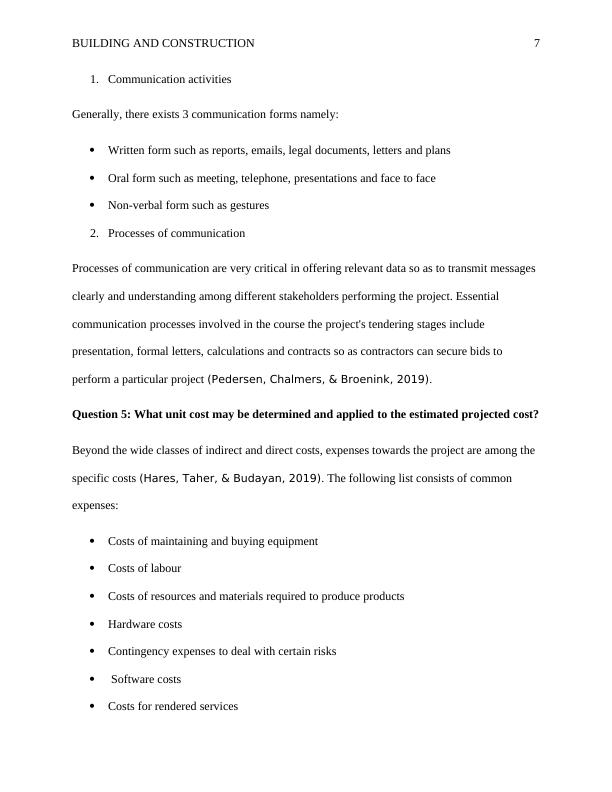
BUILDING AND CONSTRUCTION 8
Costs of using or renting facilities and services
Question 6: How many toilets must be provided on-site during construction?
Separate toilets must be generally provided at work sites in cases of both female and male
employees. On the contrary, a single unisex toilet should be offered in at work sites consisting of
both female and male employees given that:
The total population of workers at the site are 10 or below
Workers of a single gender are two or one
Unisex toilets must contain a single washbasin, a closet pan and sanitary disposal bin.
employees urinals Closet pans
Females N\A One for 5 females
Males One for 25 males One for 20 males
Table 1 above shows the ratios for separate toilets at sites (Hacker, Kaminsky, & Faust,
2019).
Question 6: What breakdown of costs may be included in the completed estimated
projected cost?
Assessment of the labour requirements
It is important to establish the salaries of the workers putting into account salary inflations and
raises.
Budget for travel
Costs of using or renting facilities and services
Question 6: How many toilets must be provided on-site during construction?
Separate toilets must be generally provided at work sites in cases of both female and male
employees. On the contrary, a single unisex toilet should be offered in at work sites consisting of
both female and male employees given that:
The total population of workers at the site are 10 or below
Workers of a single gender are two or one
Unisex toilets must contain a single washbasin, a closet pan and sanitary disposal bin.
employees urinals Closet pans
Females N\A One for 5 females
Males One for 25 males One for 20 males
Table 1 above shows the ratios for separate toilets at sites (Hacker, Kaminsky, & Faust,
2019).
Question 6: What breakdown of costs may be included in the completed estimated
projected cost?
Assessment of the labour requirements
It is important to establish the salaries of the workers putting into account salary inflations and
raises.
Budget for travel
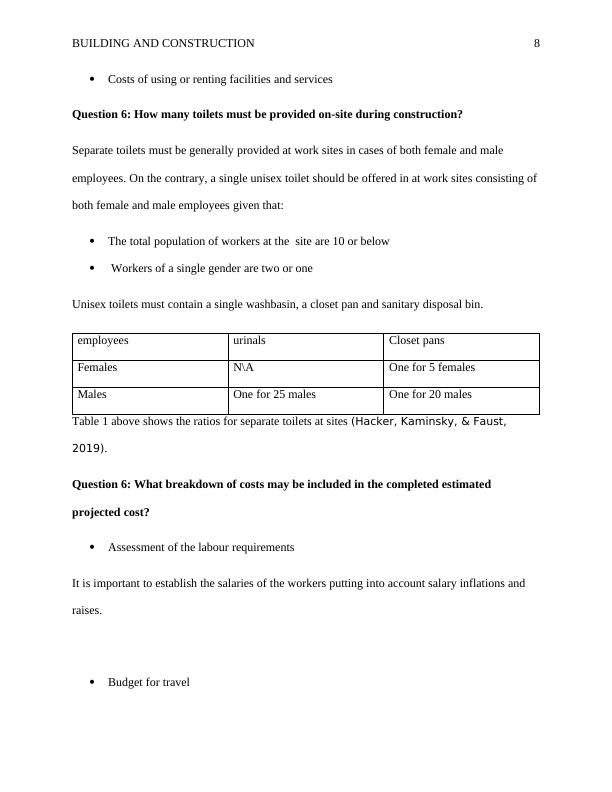
End of preview
Want to access all the pages? Upload your documents or become a member.
Related Documents
Cert IV Building and Construction: Questions and Answerslg...
|9
|1684
|386
Construction Project Management: Labor, Material, and Process Orderinglg...
|26
|5389
|170
Construction Project Management Case Studies and Processeslg...
|26
|5431
|244
Construction Site Mobilisation: Activities and Challengeslg...
|7
|1244
|243
Construction Site Operations: Risk Management, AS 4000 Application, Earned Value Analysis, Report, VOWD and Accrualslg...
|14
|2422
|322
Project Management (MGMT2060) | Winter 2020 Midterm Examlg...
|12
|1921
|17
